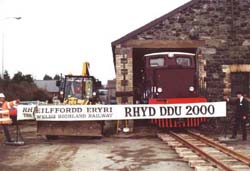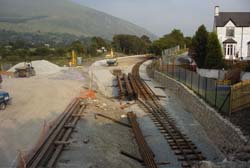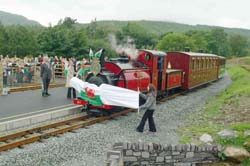|

Part 4 – Back to Life
 |
|
January
1997, Go for the project from Dinas to Caernarfon and hopes, at that
time, to make it to Rhyd Ddu by 2000.
(Eddie Bellass) |
|
|
In the early 1960s the first determined efforts to revive the
WHR began and in 1961 a group of enthusiasts formed a society which
became the Welsh Highland Light Railway (1964) Co Ltd. Negotiations
were opened with the liquidator but these efforts necessarily
changed focus when he died and the assets were transferred to the
Official Receiver in London. A base was eventually established on a
former standard gauge siding in Porthmadog and a short length of
line was laid to Pen y Mount. A public service commenced in 1980.
WHLR (1964) Ltd opened
negotiations with the local authorities and the Official Receiver
but the company’s efforts were complicated by the threat of road
improvement schemes which apparently required portions of the
trackbed too. In the late 1980s, the FR became again involved in WHR
interests, having completed restoration of the FR route, including a
2½ mile deviation, to Blaenau Ffestiniog in 1982.
In 1989 it was a matter of some controversy when it became known
that the FR had made a secret bid to acquire the WHR trackbed from
the Official Receiver. The FR plan was to start at Caernarfon,
rebuilding back to Porthmadog and connecting with the FR to create a
40 mile railway – a new ‘Great Railway Journey”.
In 1993 the FR launched the
Welsh Highland Railway Society, to focus volunteer efforts for the
reconstruction of the WHR.
 |
|
Waunfawr
station starts to take shape in July 2000 (Ben Fisher) |
|
|
There then followed several years of legal arguments, a High Court
hearing and three public inquiries, and an appeal before a decision
that the reconstruction of the WHR was in the public interest was
made and the necessary powers granted by means of a Transport &
Works Order. Along the way a transfer order sanctioned the sale of
the trackbed from the Official Receiver to the FR and a Light
Railway Order authorised the Dinas-Caernarfon section.
Work started between Dinas and Caernarfon in 1997 and engineering
contractor Mowlem made the trackbed ready for volunteer tracklayers.
It was opened on 13th October 1997, with initial trains consisting
of five new carriages. Subsequently a Pullman car, Bodysgallen, and
two more semi-opens were added to the fleet. Some FR stock was also
used and many FR locos have made appearances on the WHR from
time-to-time.
From an early stage the railway was envisaged to be reconstructed to
operate at as close to 25 mph as possible, to be operated by
powerful locomotives capable of hauling 12 coaches up gradients of
up to 1 in 40 and in such a way as to reduce long-term maintenance
costs. A large amount of the necessary equipment was sourced from
South Africa including two NGG16 2-6-2+2-6-2 Beyer Garratts (Nos 138
and 143) and the Funkey diesel Castell Caernarfon. Another Funkey
diesel was also imported and after a significant rebuild entered
service on the FR as Vale of Ffestiniog. A third NGG16, No 140, was
donated to the cause in 1997 and two NG15 2-8-0s were obtained
subsequently, following the collapse of the Robin Hood’s Bay railway
scheme.
 |
|
Prince Charles visits
Rhyd Ddu, driving FR England loco ‘Prince’ into the station. (John
Dobson) |
|
|
Funding was made available towards the estimated £9 million cost of
rebuilding to Rhyd Ddu from the Millennium Commission (£4.3m),
European Regional Development Fund, Welsh Development Agency, Wales
Tourist Board and sponsorship from the WHR Society, Historic Houses
Hotels and First Hydro.
The section to Waunfawr took about a year to finish, opening in
August 2000 and work started almost immediately on the next section
to Rhyd Ddu. However, progress was hampered by the national Foot and
Mouth disease outbreak.
Whilst these developments were
taking place WHLR (1964) Co, now registered as the Welsh Highland
Railway Ltd, reached agreement with the FR to rebuild the railway to
Pont Croesor and to operate trains of heritage rolling stock on the
completed WHR. In 2003 work started for an initial extension to
Traeth Mawr loop, about half way to Pont Croesor, but progress was
also hampered by the Foot and Mouth outbreak. The company is now
close to completing this initial section to Traeth Mawr loop.
Also in early 2003, tracklaying
started at Rhyd Ddu northwards to meet up with the section being
laid from Waunfawr southwards. Following test running and a visit by
HRH Prince Charles, the Prince of Wales, the railway was opened to
Rhyd Ddu on 18th August 2003.
Continue to
Part 5 -
"The Future".... |

